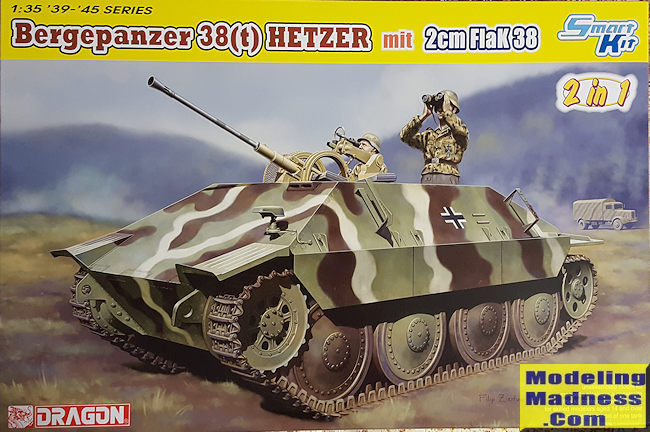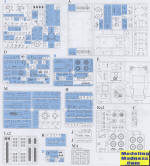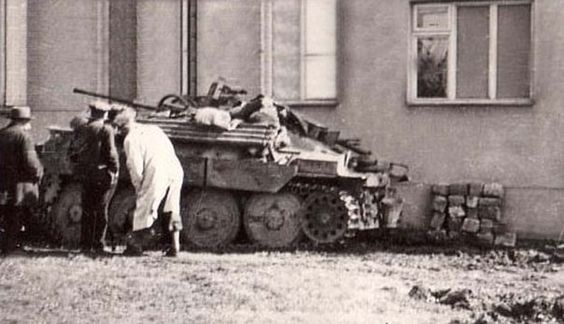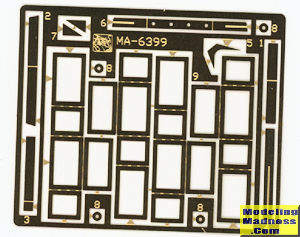
| KIT #: | 6399 |
| PRICE: | $80.00 |
| DECALS: | Generic insignia |
| REVIEWER: | Scott Van Aken |
| NOTES: | Smart Kit |

| HISTORY |
The Jagdpanzer 38 fit into the lighter category of German tank destroyers that began with the Panzerjäger I, continued with the Marder series and ended with the Jagdpanzer 38. The 75 mm Pak 39 L/48 gun of the Jagdpanzer 38 was a modified version of the 75 mm StuK 40 L/48 used in the StuG III and StuG IV assault guns. With this gun the Jagdpanzer 38 was able to destroy nearly all Allied or Soviet tank types in service at long ranges (except heavy tanks) and its fully enclosed armor protection made it a safer vehicle to crew than the open-topped Marder II or Marder III series.
The Jagdpanzer 38 was one of the most common late-war German tank destroyers. It was available in relatively large numbers and was generally mechanically reliable. Like some other late-war German SPGs, the Jagdpanzer 38 mounted a remote-control machine gun mount which could be fired from within the vehicle. This proved popular with crews, though to reload the gun a crewmember needed to expose himself to enemy fire.
Also, its small size made it easier to conceal than larger vehicles. A self-propelled gun such as this was not intended for a mobile, meeting engagement or the typical Wehrmacht blitzkrieg style of warfare. Instead, a light self-propelled gun like the Jagdpanzer 38 excelled when emplaced along pre-determined lines of sight where the enemy was expected to approach and when used in defensive positions to support a prepared ambush. The Jagdpanzer 38 is similar in its dimensions and vertical profile to the minuscule and undergunned Panzer II, a prewar tank. However, by 1944 the majority of tanks were dramatically larger and heavier, making a Jagdpanzer 38 waiting motionless in ambush a very small target to detect, much less hit. Its main failings were comparatively thin side armor, limited ammunition storage, poor gun traverse, poor internal layout that made operating the vehicle difficult, as well as leaf springs and drive wheels that were prone to failure due to the increased weight. Using the Jagdpanzer 38 and similar vehicles according to a defensive doctrine would offset some of the disadvantages of poor side armor and limited gun traverse.
As WWII wore on, German engineers attempted all sorts of conversions of existing armored vehicles to help shore up the war effort. The Czech-built Jagdpanzer 38(t) was one chassis commonly used, and an antiaircraft vehicle was one version that was planned. As the name Jagdpanzer 38(t) mit 2cm FlaK 38 signifies, it would have mounted a 20mm cannon.
Since the vehicle was used post war by the Czech and
Swiss Army, it is not surprising that this is the most numerous German AFV still
extant, though most are post war versions.
| THE KIT |
 The
Hetzer is a neat little vehicle that is popular with German WWII AFV modelers.
This kit continues Dragon's delving into prototype vehicles. Despite what the Wiki history section states, photos show that at least one was built, though it may have been a field modification.
The
Hetzer is a neat little vehicle that is popular with German WWII AFV modelers.
This kit continues Dragon's delving into prototype vehicles. Despite what the Wiki history section states, photos show that at least one was built, though it may have been a field modification. 
As you would expect, there are a number of new bits to make this version and that includes a new upper hull as well as a new engine decks and road wheels. It also has what Dragon calls NEO tracks. These are simply link and length tracks. This provides a nice choice between separate links and Dragon's DS tracks. I've built smaller scale kits using this method and it does work well and look nice.
The Dragon PR info states that one can build this as on a Bergepanzer 38(t) or standard Hetzer chassis. I cannot tell the difference as there are not little ? areas in the instructions. It does state that a few mods the builder has to make are for a B version. It also appears that many of the bits to build a standard Hetzer are there as well, but it appears that the front upper hull bits to do this are missing.
 Since it is
an open topped vehicle, you get a full driver's compartment and fighting
compartment. It also comes with a complete FlaK 38 from which you use the bits
for the gun and traverse, leaving the chassis for the spares bin. The gun can be
built angled at 20, 40 or 60 degrees. The kit includes a new firewall and a new
mount specifically for the FlaK 38. There is a small photo etch fret for what
Dragon calls 'refining detail'. Most of what you see is for the brackets to hold
the ammo cases on the gun mount.
Since it is
an open topped vehicle, you get a full driver's compartment and fighting
compartment. It also comes with a complete FlaK 38 from which you use the bits
for the gun and traverse, leaving the chassis for the spares bin. The gun can be
built angled at 20, 40 or 60 degrees. The kit includes a new firewall and a new
mount specifically for the FlaK 38. There is a small photo etch fret for what
Dragon calls 'refining detail'. Most of what you see is for the brackets to hold
the ammo cases on the gun mount.
| CONCLUSIONS |
While I'm sure some would have liked the bits to do a standard Hetzer as well, this does make for a very interesting vehicle. The instructions show two different camo schemes that would be typical for those vehicles in 1944 had they actually been built. It is a neat kit and though parts intensive as is typical for Dragon, should build up rather quickly.
| REFERENCES |
https://en.wikipedia.org/wiki/Hetzer
October 2016 Copyright ModelingMadness.com. All rights
reserved. Thanks to
www.dragonmodelsusa.com for the preview kit. You can get yours
at your local hobby shop or on-line retailer. If you would like your product reviewed fairly and fairly quickly, please
contact the editor
or see other details in the
Note to
Contributors.